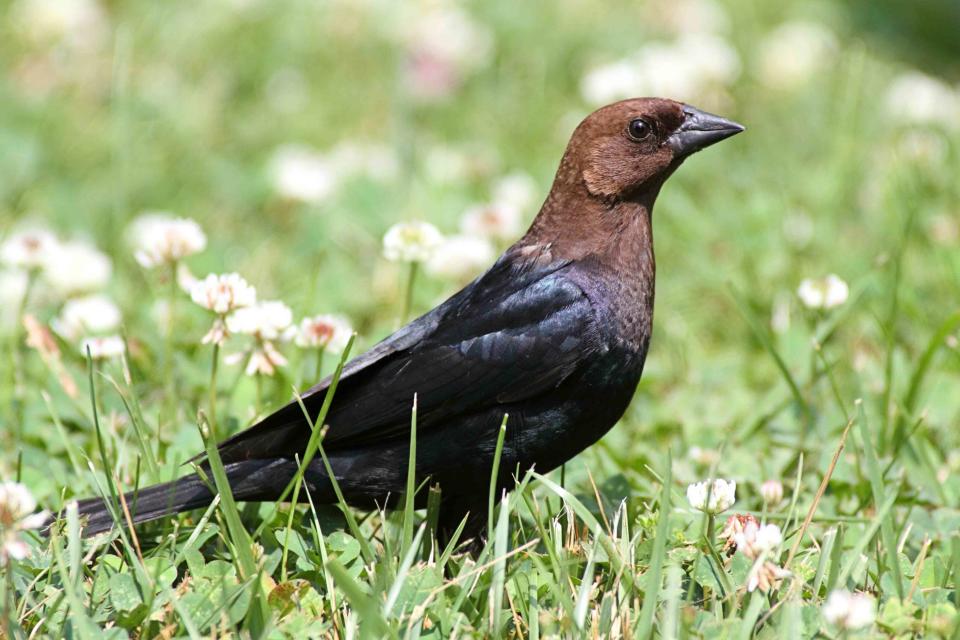What Are Cowbirds? And How To Keep Them Away
Many consider cowbirds to be a nuisance.

Getty Images/SteveByland
Setting up backyard bird feeders or a birdbath are simple and easy ways to enjoy birdwatching in your own yard while supporting local bird populations. That said, food and water supplies may also attract birds you don’t want, like the cowbird.
Brown-headed cowbirds, commonly referred to as simply cowbirds, are native to North America and many bird enthusiasts consider them a nuisance. But are they really a backyard bird bully or simply misunderstood?
Meet The Expert
Kevin Ellison is the Northern Great Plains Program Manager for American Bird Conservancy.
Here’s what you need to know about cowbirds and how to keep them out of your yard:
What Are Cowbirds?
In North America, Brown-headed Cowbirds followed bison herds and were originally called “buffalo birds” by settlers until introduced cattle were more common and then their modern name was developed. Brown-headed Cowbirds are now common throughout the U.S.
“They look like a shiny iridescent blackbird with its head dipped in chocolate and have a unique ‘gloo-gloo-glee’ call that they make,” Ellison explains, adding that female and juvenile cowbirds are mostly brown with cream colored wing bars.
All species of cowbirds are obligate brood parasites.
“That is a fancy way of saying that they never build nests and are fully dependent on locating the nests of other birds to deposit their eggs into where the cowbird hopes they will hatch and be raised by ‘host’ parents of another bird species (which are) often songbirds.”
Ellison says it is thought that the cowbirds’ dependence on keeping up with moving feeding areas maintained by the grazers helped to provide natural selection for leaving eggs in the nests of other birds rather than building their own.
Why To Keep Cowbirds Out
“Cowbirds are kind of misunderstood as we project human morals onto nature,” Ellison says of the species’ reputation.
With settlement throughout North America, the new immigrants changed the landscape, particularly by logging forests for timber and growing crops and livestock around villages. Cowbirds quickly adapted to these changes and expanded their distribution from the Great Plains, where they were once restricted from the vast forests.
These changes increased the cowbird population and brought cowbirds into contact with many forest species that were not historically faced with this ‘brood parasitism” before. It is estimated that the cowbird has parasitized more than 200 different bird species across North America.
Because cowbird eggs require a shorter incubation period–and female cowbirds can lay more eggs than most wild birds – their chances of survival in host nests surpass that of the host’s own young.
“Impacts of parasitism are different for different host species, but usually result in loss of at least one, and often all, of the 3-5 host young. Although each cowbird female only lays one egg in a nest, a high abundance of cowbirds in an area often will lead to many cowbirds parasitizing the same limited supply of host nests,” Smithsonian Migratory Bird Center scientist Lisa Petit writes.
Ellison says it’s important to recognize that since all of the native bird species are legally protected under the Migratory Bird Treaty Act–including cowbirds–it is illegal to remove their eggs from backyard nests.
“No one should feel that they need to ‘protect’ any nests as the species are native and any attempts to discard cowbird eggs will likely result in more risk than letting nature take its course,” he explains, adding that hosts develop defenses against cowbirds after they experience the cowbird egg in their nest.
How To Keep Cowbirds Out Of Your Yard
While disturbing cowbird eggs is unlawful, there are certain things that attract cowbirds and can be avoided.
Ellison says that the main attractants to cowbirds are short grass, birdseed feeders, and water.
“During the summer, most birds feed their young insects, so songbirds don’t need seed feeders as much as in the winter,” he says.
From a landscape perspective, larger forests are less permeable to cowbirds.
“In some areas it has been suggested that money spent trying to control cowbirds each year would be better spent in the long term on [forest] habitat restoration,” Ellison says. “This is especially true for woods along rivers. Basically, the more complex the habitat, the more birds can hide their nests from predators and cowbirds.”
To keep cowbirds out, NestWatch recommends:
Bird feeders that are made for smaller birds that include shorter perches and smaller holes.
Avoiding spreading food on the ground for birds and cleaning spilled seed.
Avoiding platform trays for feeding.
For feeding, “Cowbirds prefer sunflower seeds, cracked corn, and millet; offer nyjer seeds, suet, nectar, whole peanuts, or safflower seeds instead.”
Related: How To Attract Birds To Your Feeder, According To An Expert
For more Southern Living news, make sure to sign up for our newsletter!
Read the original article on Southern Living.

